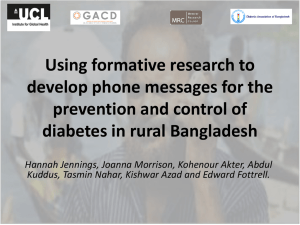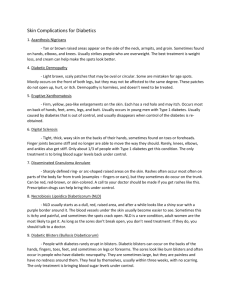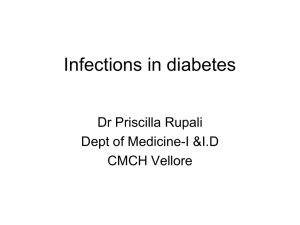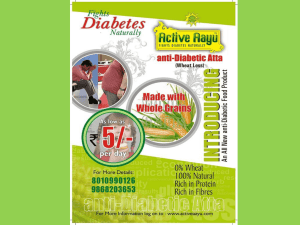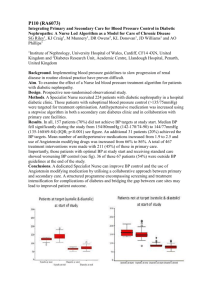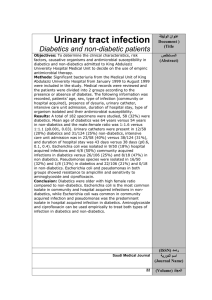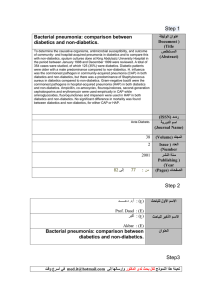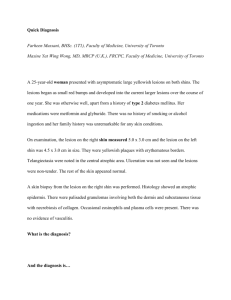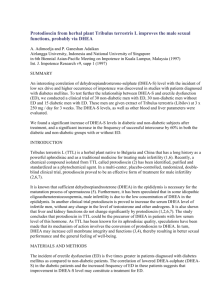SKIN DISORDERS AND ITS CARE IN DIABETES
advertisement
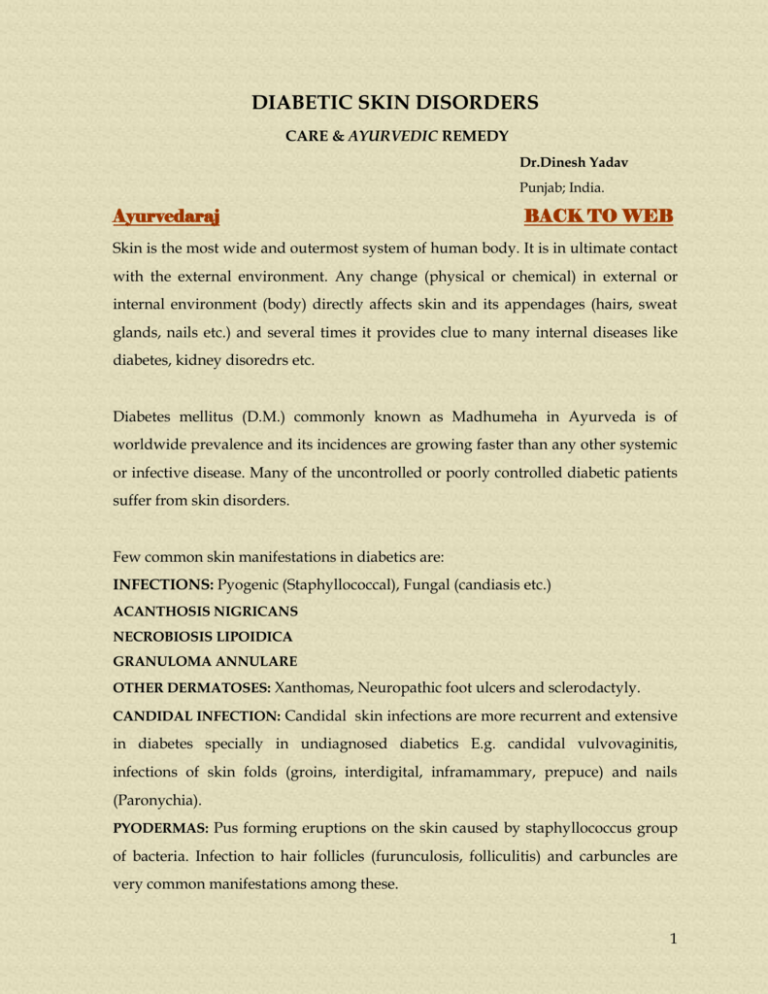
DIABETIC SKIN DISORDERS CARE & AYURVEDIC REMEDY Dr.Dinesh Yadav Punjab; India. Ayurvedaraj BACK TO WEB Skin is the most wide and outermost system of human body. It is in ultimate contact with the external environment. Any change (physical or chemical) in external or internal environment (body) directly affects skin and its appendages (hairs, sweat glands, nails etc.) and several times it provides clue to many internal diseases like diabetes, kidney disoredrs etc. Diabetes mellitus (D.M.) commonly known as Madhumeha in Ayurveda is of worldwide prevalence and its incidences are growing faster than any other systemic or infective disease. Many of the uncontrolled or poorly controlled diabetic patients suffer from skin disorders. Few common skin manifestations in diabetics are: INFECTIONS: Pyogenic (Staphyllococcal), Fungal (candiasis etc.) ACANTHOSIS NIGRICANS NECROBIOSIS LIPOIDICA GRANULOMA ANNULARE OTHER DERMATOSES: Xanthomas, Neuropathic foot ulcers and sclerodactyly. CANDIDAL INFECTION: Candidal skin infections are more recurrent and extensive in diabetes specially in undiagnosed diabetics E.g. candidal vulvovaginitis, infections of skin folds (groins, interdigital, inframammary, prepuce) and nails (Paronychia). PYODERMAS: Pus forming eruptions on the skin caused by staphyllococcus group of bacteria. Infection to hair follicles (furunculosis, folliculitis) and carbuncles are very common manifestations among these. 1 DIABETIC DERMOPATHY: Commonly called as “Diabetic skin spots”. It begins as reddish area over skin and evolve in to an area of superficial hyper pigmentation after shedding of f of scales. These are more common in elderly diabetics. ACANTHOSIS NIGRICANS: It is common in obese and insulin resistant diabetics. These are present in the form of velvety hyper pigmented plaques in axillae, inguinal region and in inframammary folds. NECROBIOSIS LIPOIDICA: It generally affects young women with type-1 D.M. It is present in the form of single or multiple asymptomatic hardened, annular, yellowish brown plaques and generally involves pretibial region and shins (portion of leg between the ankle and knee). GRANULOMA ANNULARE: These are generalized or localized reddish plaques on the limbs or trunk of the body. SLERODERMA: These are the areas of skin thickening on the back and neck at the site of previous superficial infections in diabetics. LIPOATROPHY AND LIPOHYPERTROPHY: These occur at the insulin injection sites. In lipoatrophy the subcutaneous fat at the insulin injection site appears to have melted away and leaves a saucer like depression and in lipohypertrophy the skin at the iError! Filename not specified.nsulin injection site appears as spongy localized area. It is associated with a history of prolonged use of the same injection site. XANTHOMAS: These occur in middle aged diabetics in the form of flat, slightly elevated soft rounded plaque or nodule of yellowish color on the eyelids or orbital regions due to degeneration of the orbicularis muscle. NEUROPATHIC FOOT ULCERS: These result generally due to poor blood circulation, infections and poor hygiene maintenance. SCLERODACTYLY: It is the hardening of the skin of the fingers and toes in diabetic patients. 2 PREVENTION AND TREATMENT: “Prevention is better than cure” This saying best implies in the case of diabetes because no complete remedy for D.M. has been established so far and complications of uncontrolled D.M. are more severe than the disease itself. But we can check these by use of proper medicines, diet, exercise etc. PREVENTION: To check the increased blood glucose level and to maintain it with the help of various suitable medicines. Use of low calorie diet nutritious diet like fibrous vegetables and fruits etc. Ayurvedic drugs like Shilajeet, Amla, Haridra (Turmeric) can be used as Naimittik rasayan to check the blood sugar level and to rejuvenate the body. Regular monitoring of the blood sugar level. Maintain proper hygiene of the skin by bathing, sponging etc. Methods to improve subcutaneous blood circulation should be implied E.g. massage, skin packs, patting etc. General body health should be maintained with the help of light exercises, Yogasanas (Dhanurasana, Ardha-matsyendrasana, Sarvangasana, Halasana, Yogamudrasana, Chakrasans, Bhujangasana,Chakrasana etc.) MEDICINES: Diabetic patient must be in regular contact with their Physician and take regular medicines prescribed by him. To check the increased blood glucose level and to maintain it with the help of oral hypoglycemic agents (E.g. Sulphonyl ureas, Biguanides) and Insulin. To check and to treat skin infections appropriate antifungal and antibacterial agents should be used (oral or local use or both if necessary). Ayurvedic drugs: Shilajeet ,Haridra, Guduchi, Nimb, Vijaisar, Gudmar, Methi, Karela, Triphala, Ashwagandha, Phaltrikadi kwatha, Lodhrasava, Madhvasava, Shiva gutika, Chandraprabhavati, Basantkusumakar ras are 3 very useful to check and to counteract the side effects and complications. These drugs also restore general health and boost up the immunity of the patient. Yava (Barley) is specially indicated for diabetics. Ayurvedaraj BACK TO WEB 4
